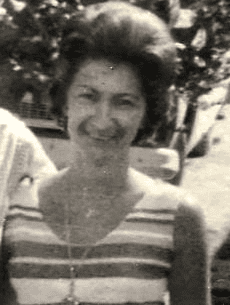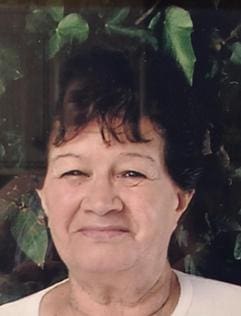Meet Lucretia (Lucky) Sorenson head decorator for Twin Winton from 1964-1974 and the other four decorators.
Meet Lucretia (Lucky) Sorenson head decorator for the Twin Winton Company from 1964-1974
In 1952 Don and Ross Winton sold their interest in Twin Winton to Bruce Winton. In 1953 Bruce moved the Twin Winton Company from Pasadena California to El Monte California where the trademark wood tone finish was developed. It was at this time that Don Winton continued designing on a freelance basis as the only designer for Twin Winton. This is the time period that Twin Winton started producing the brown stained cookie jars, salt & pepper sets, and related household accessories such as spoon rests, wall pockets, planters, kegs, napkin holders and lamps. In 1964 Bruce Winton made the decision to move the Twin Winton Company to San Juan Capistrano, California. Brad Keeler, another California pottery manufacturer, had died and his factory was for sale. Brad commissioned artists Arthur and Jean Ames to design and fabricate a mural outside his building that still stands today in San Juan Capistrano as a historical land mark and is pictured above.
Lucretia (Lucky) Sorenson.
Lucretia worked for Twin Winton in San Juan Capistrano as a decorator and air brush finisher from 1964 to 1974. Due to her exceptional painting ability Lucky became the head decorator and head air brush finisher for Twin Winton.




Lucretia was born on October 18, 1936 in Whitepine, Montana. She met her husband Willard Sorenson when she 16 years old and married him in 1953 at age 17. They were happily married for 58 years until he passed away in 2011. At the time they were married, Willard worked for the Burlington Northern Railroad as a fireman on the trains. When the dam was built on the Clark Fork River in Noxon, Montana, Willard was able to get a job as a chainman on the survey crew. He was was promoted to instrument man on the survey crew and in 1957 was offered a job in El Cajon, California. Driving a 1957 Chevy, they moved from Montana to California with their three children and a Cocker Spaniel. A couple years after their move the economy suffered a turn down and her husband was offered a job with Toups Engineering in Santa Ana, California. They then moved to San Clemente, California and later bought a home in Capistrano Beach, California. In 1964 Lucky saw an ad in the San Clemente newspaper advertising a job as a decorator for the Twin Winton Company which was opening in San Juan Capistrano and needed decorators for the new Twin Winton Line of pottery.
Lucky applied for the job at the Twin Winton Factory and there met Bruce Winton. He introduced her to Margaret who had come with Bruce Winton from the Twin Winton El Monte factory to help train decorators. Lucky was taken out into the plant where she was sat down and given a couple of paint brushes and some old greenware pottery. She was given some white, pink, yellow, blue, black and green glazes and Lucky worked her magic on the greenware. Bruce Winton watched her paint the first piece and said to her, “You have a job! Be here on Monday morning”.
Not long after working at Twin Winton the woman who did the air brushing wanted to move back to El Monte so Lucky asked if she could do the air brushing and was given the job. She soon became the head decorator and air brush finisher.
Lucky said that the clay was mixed in big tubs that had mixers like large beaters. There were large hoses that connected to the tubs of clay which hung overhead from the ceiling above the molds. The casters used these hoses to pour the clay mud into the many molds. The molds were given time to set, then checked to see if the clay had set up properly before the excess clay was removed. After removing the excess mud, the clay mud was then allowed to somewhat cure. The pottery was then removed from the molds and placed on large racks that had four or five trays on each side. The pottery molds at this time were called greenware.
After the greenware was completely dry, the racks would be taken to the finishers. The finishers would then use steel wool along with a type of carving instrument to remove the rough seams where the molds joined together and any other imperfections on the greenware. The finishers would then blow out the inside of the greenware with air hoses to remove any debris making sure it was ready for the decorators. Lucky recalls one of the finishers name, Connie Garcia.
The decorators would then use the glazes to paint the greenware molds with the appropriate colored glazes and bring the pottery to life.
A person named Irma was the kiln loader. There were three large kilns. The cookie jars were loaded on the bottom shelf. The middle shelf was loaded with napkin holders, candy dishes and the top shelf was loaded with salt and pepper shakers and spoon rests.
The night man would come in and fire the three kilns and cure the pottery. In the morning the stainers would pull the pottery, place the pottery on racks and take it all back to the staining room. Here the pottery would be dipped into large tubs of the famous Twin Winton brown stain and placed back on the racks to dry.
According to Lucky the Twin Winton Collectors Series Cookie Jars were decorated with special colors because the molds had imperfections in them and they were easily covered by the special glazes and colors.
After the pottery was dried it was taken to the packing room, packed and shipped. Montgomery Ward and Sears stores sold a lot of the Twin Winton pottery.
Lucky was one of 4 decorators, 8 finishers, 3 kiln loaders, 3 casters and the night man who fired the kilns. She said many of the decorators would put their initials on some of the Twin Winton pottery.
If you are lucky enough to have a Twin Winton piece of pottery with the initials of LS on the bottom you have a piece of Twin Winton pottery decorated and brought to life by Lucky Sorenson.
If you have a Twin Winton piece of pottery with the initials of LO it was decorated by Lois Oehlert, VS is Valinda Sorenson, PA is Paulette Allen and JO is Jenny Ortega.
During the early 1970s Twin Winton was a family affair when Lucky got her daughter Valinda Sorenson, her son Rick Sorenson, her niece Lois Oehlert and nephew Paul Oehlert had jobs at the Twin Winton Company. All were in high school and worked part time in the evenings and on weekends.
Lucky said Charlie Buyers was the plant manager during her time at Twin Winton. She said he was a wonderful man with a heart of gold.
Lucky also said that during the time (1964-1974) that she worked at Twin Winton, the California Clock Company that produced the world famous Kit-Cat Clocks was located in the same building as Twin Winton and the Twin Winton employees assembled the clocks and shipped them. During this time Bruce Winton along with Bruce Wagner became part owners in the California Clock Company. When Twin Winton closed in 1976 Bruce Winton sold his interest in the California Clock Company to Bill Wagner.
Lucky said Bruce Winton was a wonderful person to work for and took her and other employees on plane rides in his airplane to Catalina Island, California. It was like one big family working at Twin Winton. She loved the years that she worked for Twin Winton and is amazed at the popularity of Twin Winton.
Bruce Winton kept the factory in San Juan Capistrano until 1976 when he sold it to Roger Bowermeister and sons. The Browermeisters ran the business for only a year trying different glazes but were unable to make enough money to support themselves. After only one year the Bowermeisters declared bankruptcy and the business went back to Bruce Winton. He decided to auction off the assets including the molds. Al Levin of Treasure Craft bought the molds and produced some of the Twin Winton Designs under the Treasure Craft name. The molds have since been destroyed and thus the end of Twin Winton.






